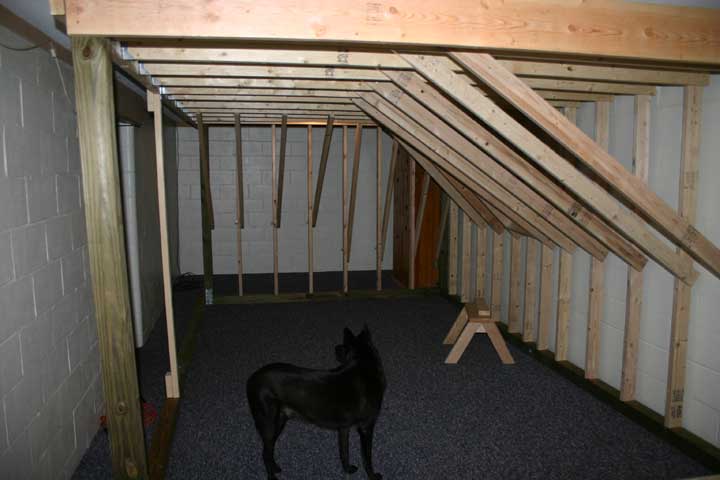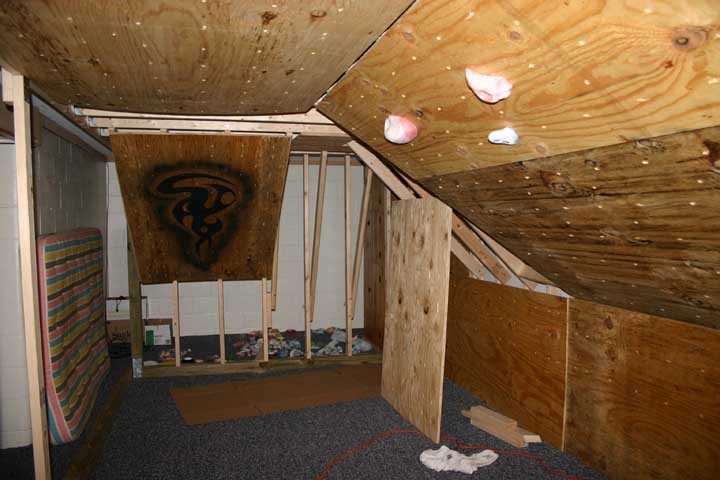|
|
BMJ
·
Sep 22, 2013
·
Unknown Hometown
· Joined Sep 2013
· Points: 0
If you'd be willing to share some thoughts on how I could best use the space I have to build a woody, I'd greatly appreciate it. I've gotten some good info from the "what does your woody look like" thread, but had some questions.
Basically, I have the room to build a wall that's 12 feet wide, with plenty of depth to accommodate a steep angled wall, but ceilings that are only about 6'10". (I say "about" because there are some panels I could remove that might give another inch or so.) Given these limits, I'm thinking of building a simple wall -- all one angle, probably 45 degrees, perhaps with a panel on the ceiling for a short roof. By my calculations, and assuming I use a 10" kick panel, this would yield a vertical climbing surface of about 8'5"; so in total the wall would be 12 feet wide and 8.5 feet tall.
I'd welcome any general thoughts on this approach, but was wondering in particular if anyone has any thoughts on a few specific things:
-- Should I shorten the kick panel? Obviously the smaller the panel, the longer the climbing surface, but it seems that a kick panel also helps to make the best use of the space one does have.
--Given the low ceiling, would anyone recommend using a steeper angle to eke out a bit more vertical space? The wall essentially would be three 4' plywood panels, and I'm considering placing one of the end panels at a 60 degree overhang. This would increase the vertical length of that panel to 12'.
Thanks for any thoughts.
|
|
|
TBlom
·
Sep 22, 2013
·
Unknown Hometown
· Joined Jun 2004
· Points: 360
Small walls tend to get boring quick, so steeper tends to be more fun. I would go mostly horizontal, with maybe a short inclined wall as a footer. Anything vertical won't get used IMO.
I've been a part of a few indoor type walls, this was by far the best and most fun.
sugar loaf woody
This wall ended up with an add on vertical/45 section, and had an available 35 foot horizontal loop. We made a lot of holds out of hardwood scrap.
|
|
|
jonathan.lipkin
·
Sep 22, 2013
·
Brooklyn, NY
· Joined Dec 2012
· Points: 70
I built a wall this summer in a basement that was not much higher.I had a lot of horizontal room, so I built 12'along one wall, and 12' along the other. 12' is a good length for traversing, which I did on the vertical wall. I then built a 45 and 30 on the other. For the 45, I built, as you are planning, about 10" kick panel, which allowed me to make two or three moves up the wall.
|
|
|
Woodchuck ATC
·
Sep 22, 2013
·
Unknown Hometown
· Joined Nov 2007
· Points: 3,280
All roof moves and holds.,,,traverse that whole low ceiling upside down from buckets to pinch moves all the way. Can't do much else if it's that low.
|
|
|
Doug Lintz
·
Sep 22, 2013
·
Kearney, NE
· Joined Apr 2004
· Points: 1,196
I built one in the low ceiling basement of a house I was renting in 2006. I built a freestanding box with 4x4s and 2x8s for the outer structure and 2x4 studs. It didn't touch any walls and I had about an inch clearance to the ceiling. It was 16 feet long, 8 feet deep and 6' 8" floor to horizontal section. Two sides of the "cube" were left unsheeted. Here's some of the few pics I have.
|
|
|
BMJ
·
Sep 22, 2013
·
Unknown Hometown
· Joined Sep 2013
· Points: 0
Awesome feedback guys. Thanks!
jonathan.lipkin -- On the 45, is that 2-3 moves straight up, or going from one bottom corner diagonally up to the other top corner? Since you have a wall much like what I'm contemplating, do you think the 45 wall could benefit from a portion that's steeper, like 55-60 degrees?
Woodchuck ATC -- I'm thinking a section set at 60 degrees would be almost like traversing on the roof.
Doug Lintz -- That looks awesome! It's making me consider some more ambitious designs. May I ask why you used such a large kick panel given the limited ceiling height? I'm struggling w/this because, looking at your picture, the large kick panel seems to allow you to more fully use the wall, but also reduces the length of the panel. Also, wound you happen to recall the angles of the various walls?
Thanks again all for the help.
|
|
|
jonathan.lipkin
·
Sep 23, 2013
·
Brooklyn, NY
· Joined Dec 2012
· Points: 70
Quote:
Awesome feedback guys. Thanks! jonathan.lipkin -- On the 45, is that 2-3 moves straight up, or going from one bottom corner diagonally up to the other top corner? Since you have a wall much like what I'm contemplating, do you think the 45 wall could benefit from a portion that's steeper, like 55-60 degrees?
/quote
Straight up. I think I could get one more move in if I went diagonally. More moves from a sit start, obviously. Brooklyn Boulders has a pretty cool section where there is about four feet vertical, then a 60-70 degree overhang, then vertical again, like this:
|
\
|
I think this is a picture of it
Here's another interesting part of the gym:
|
|
|
Doug Lintz
·
Sep 24, 2013
·
Kearney, NE
· Joined Apr 2004
· Points: 1,196
BMJ,
We used a larger kicker mostly out of ignorance. We knew we wanted at least 4 feet of roof and a shorter kicker wouldn't allow us to achieve 55 degrees for the main overhanging section. In retrospect, a 2 foot kicker would've been fine as well.
For angles (in my 3rd photo):
The far section on the left was 45 degrees, the right section was 30 degrees. The section that I'm climbing on was 55 degrees. This transitioned into a 45 degree section (hard to see in the photo). The transitions was a pain in the ass. I used several smaller pieces of plywood to avoid creating a vertical, left facing triangle between the differing sections.
This woodie was a bit cramped but a lot of fun given my space limitations. It was extremely solid and didn't creak or sway, even with multiple climbers at once. Those steep angles did do a number on my finger joints and I eventually quit using it and returned to gym (vertical) climbing.
All of my pics were taken from the end of the room where I had my bar. Given how much beer we drank while bouldering, it's amazing no one got hurt. Good luck with your project.
|
|
|
BMJ
·
Sep 29, 2013
·
Unknown Hometown
· Joined Sep 2013
· Points: 0
Thanks again, all.
I'll probably make a separate thread about this at some point, but does anyone have any thoughts on the usefulness of a wall overhung 60 degrees from vertical? This would be quite steep, but I could ease the angle a bit in some places w/volumes. I'm considering this b/c, with a low ceiling, a steeper angle obviously yields larger climbing surface. I've also been exploring building in our attic, and the rafters are at about 60 degrees.
|

 Continue with onX Maps
Continue with onX Maps Continue with Facebook
Continue with Facebook

























